 The Formative period for the central Andean cultural area is called Formative Andean, this is the first period of the stage of the High Cultures of the Era of Autonomy, begins with the appearance of ceramics that occurred in the Ucayali basin with the Tutishcainyo1, 2 culture and with the Wairajirca phase of the Kotosh culture in the mountains and on the coast at the large site archaeological site of the Haldas near Casma, approximately in 1800 a. C. and in the Limeña Region in Ancón, in 1600 a. C.3 and ends with the disintegration of the Ceremonial Center of Chavín de Huantar. Among the most important achievements are goldsmithing, hydraulics, improvement of agricultural techniques, religious expansion and exaltation of textile art. The Formative period represents a time span of about fifteen hundred years, roughly between 1700 and 200 B.C. (based on calibrated C14 dates).
The Formative period for the central Andean cultural area is called Formative Andean, this is the first period of the stage of the High Cultures of the Era of Autonomy, begins with the appearance of ceramics that occurred in the Ucayali basin with the Tutishcainyo1, 2 culture and with the Wairajirca phase of the Kotosh culture in the mountains and on the coast at the large site archaeological site of the Haldas near Casma, approximately in 1800 a. C. and in the Limeña Region in Ancón, in 1600 a. C.3 and ends with the disintegration of the Ceremonial Center of Chavín de Huantar. Among the most important achievements are goldsmithing, hydraulics, improvement of agricultural techniques, religious expansion and exaltation of textile art. The Formative period represents a time span of about fifteen hundred years, roughly between 1700 and 200 B.C. (based on calibrated C14 dates). In order to avoid misunderstandings, it should be pointed out that there are basically two chronological systems since the 1960s, since previous ones have already fallen into disuse. In the first chronological system, the Formative period emphasizes an evolutionary facet, conceived as a process, whose term, initially, was borrowed from the History of Art, in which a Formative precedes a Classic, as is still in use for the area of Mesoamerica or Central America. In Peru, this period is after an Archaic period and before the Regional Developments period. This scheme was popularized by Luis G. Lumbreras. Another system was developed by John H. Rowe (1918-2004), who systematized the chronology of Ancient Peru by using subdivisions of periods (Initial Period, Early Intermediate Period, and Late Intermediate Period) and horizons (Early Horizon, Middle Horizon, and Late Horizon). ). In this scheme, the Formative corresponds to the whole of the Initial Period (initial due to the introduction of ceramics) and the Early Horizon.
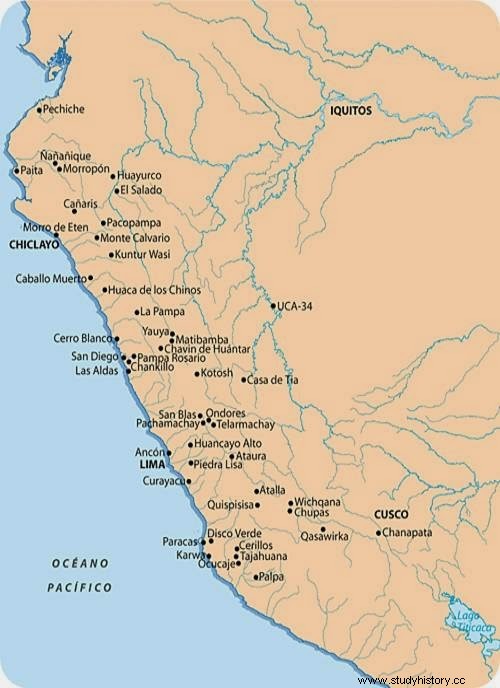 Formative Archaeological Sites
Formative Archaeological Sites It is divided into three stages:
Lower Formative
Also called Initial Formative or Prechavín period, in this stage expressions prior to the emergence of Chavín are developed, such as Pacopampa, Kuntur Wasi, Kotosh Wairajirca, Sechín Alto, etc. Ceramics and goldsmithing appeared at this time.
Middle Formative Also known by the name of Formative Synthesis, in this period the Chavín Culture is fully developed with its main center Chavín de Huantar, a focus of cultural and religious irradiation, in this stage monochrome ceramics and lithic sculpture are notably developed.
Higher Training Other names given to this period are Final Formative, Transitional Formative. The celebrity achieved by Chavín de Huantar, the main center of the Chavín Culture, thanks to its religious power, will cause regions that previously depended on that ceremonial center to emerge as new ceremonial centers with their own styles, becoming completely independent after a few hundred years of Chavín influence. , thus marking the complete decline of the Formative period identified with the Chavín Culture, thus giving way to the Early Intermediate. Taking as reference only the Chavín Culture, its emergence and decline, the last two periods is also known such as Chavín Horizon or Early Horizon.
THE APPROACHES ON THE ECONOMY OF THE FORMATIVE
Tello maintains that: The civilization of the Andes had as the foundation of its extraordinary development, the exploitation of the resources of mineral, vegetable and animal origin, through the working of the mines, the carving of the stones, the cultivation of the
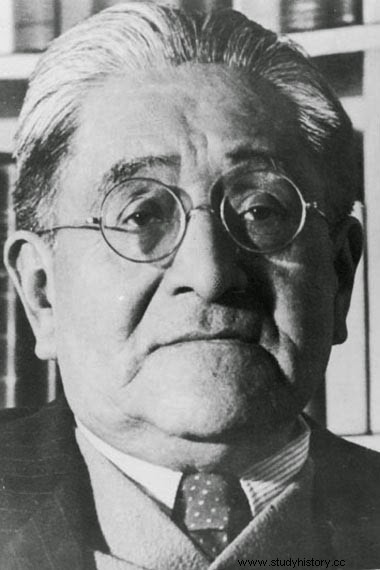 Julio César Tello plants and the domestication of animals… It could be affirmed that the Andean Civilization arose and radiated from a single natural source of wealth and from a single ideal of life:the Andean land and the ingenuity of the Indian placed at its service; the conservation and propagation of the land making it more conducive to animal and human life; and human effort, directed towards the pursuit of material and spiritual well-being, through cooperative and coordinated work. The Indian population of the Andes was agricultural par excellence. Any other of the manifestations of their activities, such as animal husbandry and manufacturing, were secondary or were subordinate to the first... Hence these holes and ravines were the primitive settlements whose remains are all the more abundant the greater the extension. of arable land. Hypothetically, it could be stated that the ruins of a population, the area it occupies and the density of its remains, is in direct proportion to the greater or lesser extent of arable land.
Julio César Tello plants and the domestication of animals… It could be affirmed that the Andean Civilization arose and radiated from a single natural source of wealth and from a single ideal of life:the Andean land and the ingenuity of the Indian placed at its service; the conservation and propagation of the land making it more conducive to animal and human life; and human effort, directed towards the pursuit of material and spiritual well-being, through cooperative and coordinated work. The Indian population of the Andes was agricultural par excellence. Any other of the manifestations of their activities, such as animal husbandry and manufacturing, were secondary or were subordinate to the first... Hence these holes and ravines were the primitive settlements whose remains are all the more abundant the greater the extension. of arable land. Hypothetically, it could be stated that the ruins of a population, the area it occupies and the density of its remains, is in direct proportion to the greater or lesser extent of arable land.LOCATION: The archaeological site of Sechín is located in the department of Ancash, province of Casma, 5 kilometers from the city of the same name, on the northern slope of Cerro Laguna, 90 meters above sea level.
Background In 1919, the learned Julio C. Tello, father of Peruvian archaeology, on his way back from the Archaeological Expedition of the University of San Marcos to the Department of Ancash (ruins of Chavín de Huántar), visited the Tabón hacienda in the Casma Valley, owned by the doctor of Chilean nationality Dr. Nicolás Sierra Alta, who had formed an interesting collection of pre-Hispanic objects obtained from cemeteries in that area. Tello visited it and was very impressed with it, so Dr. Sierra Alta donated a representative batch of pieces to the San Marcos University Archeology Museum (where Tello was director). Upon the death of Dr. Sierra Alta, the collection passed into the possession of Mr. Juan I. Reyna.
ECONOMY: They dedicated themselves to agriculture, livestock and handicrafts. Until a few decades ago it was claimed that the corn in the Andes was brought from Central America. However, research has shown that maize is found in archaeological levels dating back to 6,000 BC. and that these varieties of corn come from a local species and not from Mexico, as was supposed. The domestication of maize was a long process but it became one of the basic products of the Andean diet,
SECHÍN RESEARCHERS: Julio C. Tello and other archaeologists, in patient work, have found more than 100 stone motifs in the Sechín temple. the 1st. July 1937 is the date of baptism of the monument with the name of Cerro Sechín Temple, as one of the results of Tello's investigations through his "Marañon Archaeological Expedition", sponsored by the Universidad Nacional Mayor de San Marcos de Lima and the help of the Institute of Andean Research and Mr. Nelson A. Rockefeller. The "Expedition" had three clear objectives:1° Carry out a comprehensive reconnaissance of the archaeological monuments of the North Coast and, especially, of the regions of the Alto Marañón, Alto Huallaga and Alto Ucayali. 2° Through these works and their results continue supporting the origin and development of the old cultures of Peru, originating in the Amazon forest, later rising in the Andes, where it is consolidated with the culture Chavín and, finally, influencing the coast.3° "Since Archeology has the vision of reviving the past, that is, of extending History beyond merely written memory, any contribution in favor of this purpose should be based on the observations and data obtained directly in the centers that offer
Federico Kauffmann He says that the many severed heads and representations of anatomical remains of people may allude to the fact that Sechín was a center for human sacrifice.
Jiménez Borja he says, that they represent a battle, where there are winners and losers.
ARCHITECTURE: An architectural complex of 6 buildings was found, the Sechín Alto temple is one of the largest in the world with an area of 400 hectares and 35 m high. The archaeological zone covers about 5 hectares and is made up of: Architectural complex of seven buildings making up a temple-palace: Six built with stones and mud motre. One built with conical and conical adobes joined with mud. Walls that delimit the complex, thick and high.
The Temple of Cerro Sechín is one of the most important archaeological monuments in Peru, given its antiquity and architectural beauty. It corresponds to the Formative period, 1800-200 years BC. It was discovered in 1937 by the archaeologist Julio César Tello. The archaeological site is located on the northern slope of Cerro Laguna, five kilometers from the city of Casma, department of Ancash, and just over ten kilometers from the sea. It is part of the so-called Premontane Desert, with a hot and dry climate.
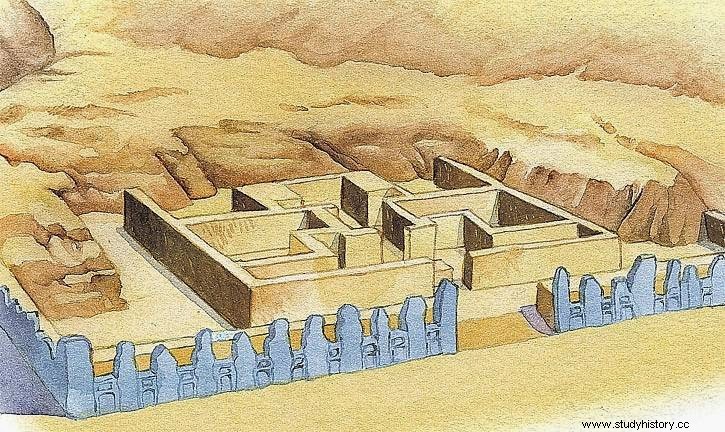
The monument is built on an area of about five hectares. It presents seven structures, six of them made with stone and mud mortar and one with conical adobes, typical of the Archaic Period (1600 before our era). Two of the structures occupy the central part, one of them corresponding to the so-called "Main Building" that covers the old structure of conical adobes with mud reliefs. The other four are located paired on both sides of the main building. They are building A, building C, platform Larco Hoyle and Julio César Tello. The Temple of Cerro Sechín is a quadrangular building 51 meters on a side with a perimeter wall of engraved stones on its external face. The interior is made up of several rooms and structures in adobe, with the walls painted in bright colors and representations of mythological figures, also painted. The more than 300 engraved figures that adorn the walls around the building, stage the bloody wars sustained by the ancient towns of the Casma basin. Warriors and mutilated bodies, bleeding arms and heads, severed bodies and legs, among other human remains are represented.
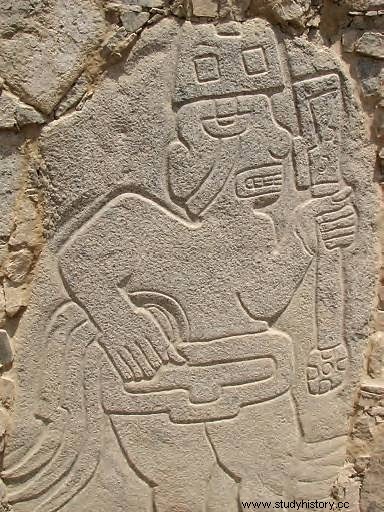 Victorious Sechín warrior The investigations carried out point to Sechín as an old farming village with an important architectural complex, with a political-religious function. It is a palace temple that was surrounded by a small village and was later destroyed by the occupation of another town. The Cerro Sechín Archaeological Complex has a Site Museum, called Max Uhle in memory of the German archaeologist who discovered the Mochica culture. and Nazca whose studies he carried out in the area, in the final years of the 19th century and the beginning of the 20th century.
Victorious Sechín warrior The investigations carried out point to Sechín as an old farming village with an important architectural complex, with a political-religious function. It is a palace temple that was surrounded by a small village and was later destroyed by the occupation of another town. The Cerro Sechín Archaeological Complex has a Site Museum, called Max Uhle in memory of the German archaeologist who discovered the Mochica culture. and Nazca whose studies he carried out in the area, in the final years of the 19th century and the beginning of the 20th century.ENGRAVED MONOLITHS: In Sechín Bajo there are steles with bloody scenes, decapitated human heads, mutilated arms and legs, according to some archaeologists it represents a fight where there are winners and losers, according to Kauffman it represents a center where human sacrifices were offered. We can observe representations of anthropomorphic characters recognized as warriors or pontiffs carrying scepters and hats, and next to them sectioned parts of the human body such as rows of eyes, arms, sectioned legs, pelvis, human heads, etc. They adorn the entire contour of the Main Building. The engraved stones were placed interspersing large ones with representations of Warriors / Priests with stacks of 3 or smaller ones with representations of human remains. For the archaeologist Lorenzo Samaniego, these bas-reliefs show a double procession of characters that starts from a portico formed by 2 engraved monoliths that support a lintel in the center of the south wall and move towards another portico, located in the center of the north wall, and interspersed, as It was already said, there are the engravings that represent human remains (arms, legs, heads, severed bodies, vertebrae and viscera) as if they were scattered on the ground, recreating a picture of deep drama and horror. In this procession there are no figures of gods, demigods or mythical animals, only men.
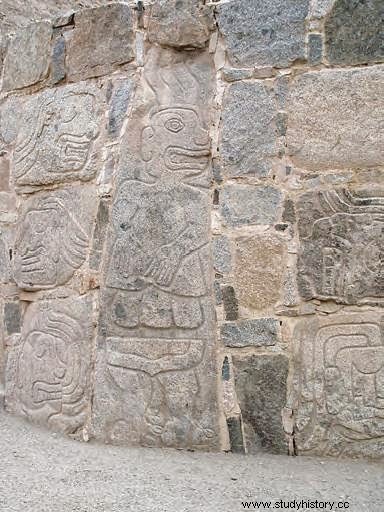 Sechín warrior with captured prisoner The Warriors / Priests they were drawn with the head, legs and arms in profile, while the trunk and pelvis are from the front. As their only clothing they wear loincloths and trapezoidal hats on their shaven heads. The face is possibly painted, judging by a curved band that appears to cross its eye. They hold a weapon or scepter in their hand, in which we must highlight the curious detail of the nail on the thumb:it is very long and sharp. The half-open mouth shows the teeth together, and its eyes are exorbitant, just as, centuries later, they were represented in the stone carvings of the Chavín de Huantar site, which was considered by Tello as the cradle or matrix of the entire Andean civilization.
Sechín warrior with captured prisoner The Warriors / Priests they were drawn with the head, legs and arms in profile, while the trunk and pelvis are from the front. As their only clothing they wear loincloths and trapezoidal hats on their shaven heads. The face is possibly painted, judging by a curved band that appears to cross its eye. They hold a weapon or scepter in their hand, in which we must highlight the curious detail of the nail on the thumb:it is very long and sharp. The half-open mouth shows the teeth together, and its eyes are exorbitant, just as, centuries later, they were represented in the stone carvings of the Chavín de Huantar site, which was considered by Tello as the cradle or matrix of the entire Andean civilization.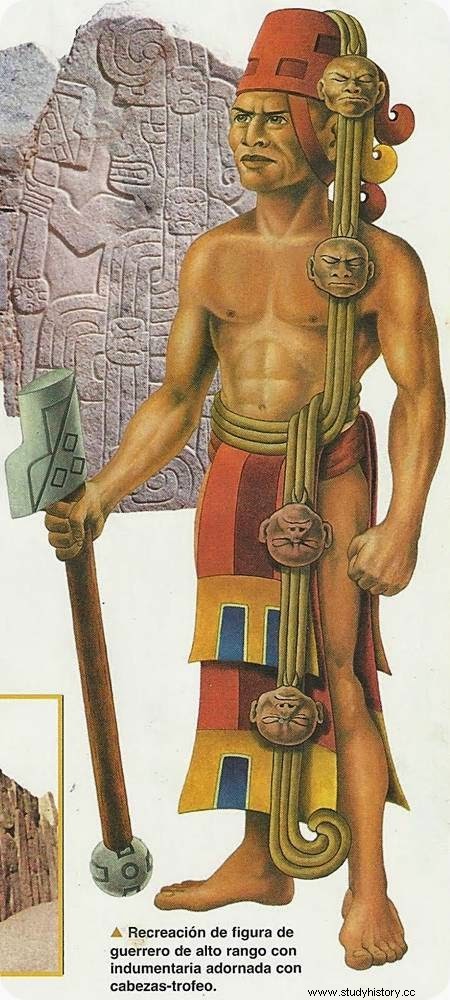 Recreation of a sechín warrior
Recreation of a sechín warrior 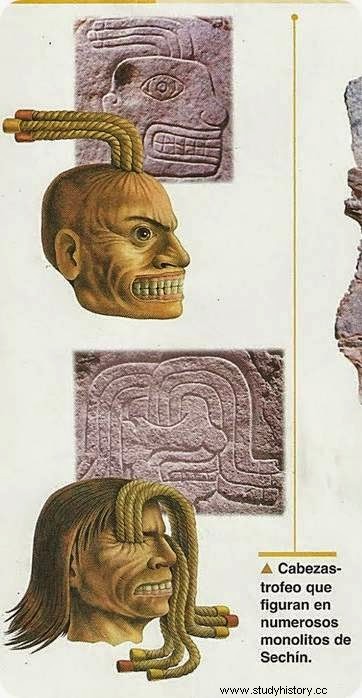 Trophy head CLAY RELIEF AND THE CULT OF THE SEA A procession walks slowly, a man, a shaman (priest) and others have crossed the silent desert, from the valley, they arrive at a sacred place, they climb some stairs, the sound of the sea accompanies them but they cannot be seen. Suddenly, upon reaching the end, it opens up imposingly, the vastness of the sea, below, a high cliff, a narrow bay, rocks outcropping, the water very agitated, foamy. The man is thrown, falls, falls off the cliff, dies. His blood reaches the surface, his body is devoured by the fish. That year was bad, there is not enough water for the crops, but now it will be good. The rite has been fulfilled. The previous account is fictitious, but it probably occurred 3,500 years ago in Sechín, according to archaeologist Henning Bischof, who has studied the clay reliefs of the Temple of Cerro Sechín and has identified a ritual complex in them. of human sacrifices and the sea, associating it with the well-known schemes of the propitiatory rites of the rain in the Andes. These reliefs are found on the walls of an adobe building, whose construction predates the platform of engraved stone tombstones that covered it in later times and is the one that today looks like a façade.
Trophy head CLAY RELIEF AND THE CULT OF THE SEA A procession walks slowly, a man, a shaman (priest) and others have crossed the silent desert, from the valley, they arrive at a sacred place, they climb some stairs, the sound of the sea accompanies them but they cannot be seen. Suddenly, upon reaching the end, it opens up imposingly, the vastness of the sea, below, a high cliff, a narrow bay, rocks outcropping, the water very agitated, foamy. The man is thrown, falls, falls off the cliff, dies. His blood reaches the surface, his body is devoured by the fish. That year was bad, there is not enough water for the crops, but now it will be good. The rite has been fulfilled. The previous account is fictitious, but it probably occurred 3,500 years ago in Sechín, according to archaeologist Henning Bischof, who has studied the clay reliefs of the Temple of Cerro Sechín and has identified a ritual complex in them. of human sacrifices and the sea, associating it with the well-known schemes of the propitiatory rites of the rain in the Andes. These reliefs are found on the walls of an adobe building, whose construction predates the platform of engraved stone tombstones that covered it in later times and is the one that today looks like a façade.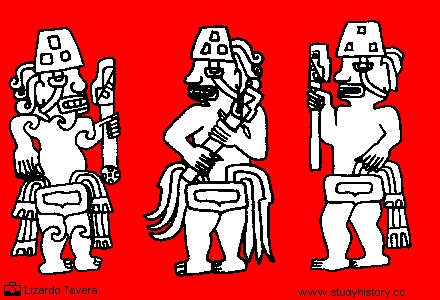
OTHER ARCHAEOLOGICAL SITES OF THE FORMATIVE Curayacu or San Bartolo (South) Hacha (Ancash) Marcavalle (Cusco) Pacopampa (Cajamarca) Chanapa (Cusco) Wichqana (Ayacucho)
